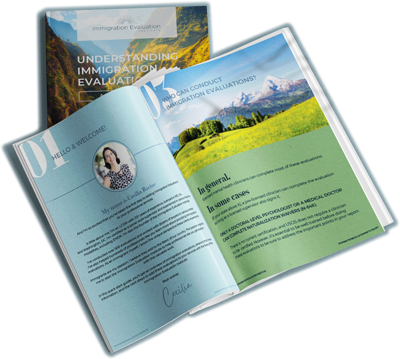What do you want to learn more about?
Vicarious Traumatization and Self-Care: An Essential Guide for New Immigration Evaluation Professionals

As therapists and mental health professionals working in immigration evaluations, we play a vital role in helping others navigate through the challenges that come with the process. It can also mean our clients share significant details about their lives as we explore their psychological backgrounds and the journeys they’ve been on.
I often find new professionals coming to the field are surprised to discover this, or at least surprised to discover how often it comes up and how much of an impact it can have on them during their work.
And I get it; completing an immigration evaluation, on the surface, looks like a straightforward set of forms and documents.
But a lot can come up in a session with a client.
In providing care, we may inadvertently absorb some of our clients’ emotional weight. This is vicarious traumatization, a critical aspect of our work that requires attention and proactive self-care.
What is Vicarious Traumatization?
McCann and Pearlman (1990) introduced the concept of vicarious trauma to explain the impact of working with clients who have experienced trauma on the therapists themselves. Before this, the phenomenon was often referred to as ‘secondary traumatic stress,’ a term coined by Dr. Charles Figley.
Vicarious traumatization, also known as compassion fatigue, occurs when therapists and mental health professionals begin to experience symptoms similar to those of their clients. This happens due to prolonged exposure to the traumatic stories and emotions shared by clients.
It’s crucial to recognize that this is a normal response to the demanding nature of our work, and acknowledging it is the first step towards effective self-care.
5 Signs You Might Be Experiencing Vicarious Traumatization
Knowing what vicarious traumatization is and what it might look like in your practice and life are very different things.
It’s important to note that vicarious traumatization can look different for everyone, and the signs I’ve included below are just a brief overview of how it might be impacting you:
- Emotional Overload: If you consistently feel overwhelmed by your clients’ stories, struggle to emotionally detach from their experiences, or experience intense emotional reactions after sessions, it’s a sign that you might be experiencing vicarious traumatization.
- Physical Symptoms: Physical symptoms such as chronic fatigue, headaches, digestive issues, or sleep disturbances might indicate that you are absorbing the stress and emotions of your clients, which can lead to vicarious traumatization.
- Reduced Empathy: A noticeable decline in your ability to empathize with your clients or a growing sense of numbness might suggest that you’re reaching a point of vicarious traumatization. This reduced empathy can hinder the effectiveness of your therapeutic interventions.
- Isolation: If you start distancing yourself from friends, family, or colleagues and find it challenging to discuss your work or your feelings with others, it’s essential to recognize that this isolation can be a sign of vicarious traumatization.
- Flashbacks or Intrusive Thoughts: Experiencing flashbacks or intrusive thoughts related to your clients’ traumatic experiences, even when you’re not in a session, is another indicator of vicarious traumatization.
4 Self-Care Practices for New Professionals
It might sound like common sense to say that one of the key ways to handle and process vicarious traumatization is through self-care, but I find sometimes we’re so engaged and involved in our work that we too can slip on the things vital to ensuring we look after ourselves.
When it comes to self-care in this area of our life and work, a few things can make a significant positive difference. Below are a few that I’ve found have benefitted me, but there are plenty more to explore, and it’s worth trying out a few and seeing what works best for you, personally and professionally:
- Regular Supervision: Engage in regular supervision or consultation with experienced colleagues or supervisors. This allows you to discuss challenging cases, share emotions, and receive guidance, which can significantly mitigate the risk of vicarious traumatization.
- Boundaries: Set clear boundaries between your personal and professional life. Establish specific working hours, and when you’re off the clock, try to disconnect from work-related concerns. This separation helps create a space to recharge and focus on your well-being.
- Self-Compassion: Treat yourself with the same compassion and understanding you extend to your clients. Acknowledge that your feelings are valid and that you need self-care just as much as anyone else. Engage in mindfulness practices, meditation, or journaling to promote self-compassion and reduce stress.
- Diversify Your Work: If possible, diversify your client base to prevent over-identification with a particular type of trauma. This can help reduce the risk of vicarious traumatization by offering you a broader range of experiences to draw from.
Self-Care & Support: Looking Ahead
Staying on top of vicarious traumatization requires ongoing awareness and proactive practice.
Whether you’re new to immigration evaluations, have been doing them for a while, or are well established, we can all benefit from dedicating a little time to how vicarious traumatization may be showing up in our lives and our colleagues.
Here are a few suggestions to support you with this important issue going forward:
- Continuous Learning: Stay informed about the latest research and techniques in the field. This enhances your professional skills and helps you develop a broader perspective, reducing the likelihood of vicarious traumatization.
- Regular Self-Assessment: Periodically assess your emotional state and well-being. Recognize when you might be struggling, and don’t hesitate to seek support or take a break if needed.
- Peer Support Groups: Join peer support groups or online forums where you can connect with other mental health professionals. Sharing experiences, insights, and challenges with colleagues who understand your work can be incredibly therapeutic.
- Seek Personal Therapy: Consider engaging in your own therapy sessions. It can be immensely helpful to have a dedicated space to process your feelings, discuss your experiences, and receive support from a fellow professional.
If you’re keen to learn more on the topic, I have a couple of other blogs that you might find beneficial:
- What is Vicarious Traumatization & Its Symptoms?
- How to Reduce Your Risk of Vicarious Traumatization
Let’s Look Out for Ourselves – And Each Other
In the demanding and rewarding field of immigration evaluations, taking care of yourself is not just a luxury – it’s an absolute necessity.
Vicarious traumatization is a real and common risk, but with awareness, self-compassion, and a commitment to self-care, we can continue to provide meaningful support to our clients while maintaining our well-being.
By prioritizing self-care, you’re not just helping yourself but also ensuring that you can continue to positively impact the lives of those who turn to you for support, guidance, and healing.

I’m Cecilia Racine, and I teach therapists how to help immigrants through my online courses. As a bilingual immigrant myself, I know the unique perspective that these clients are experiencing. I’ve conducted over 500 evaluations and work with dozens of lawyers in various states. Immigrants are my passion, I believe they add to the fabric of our country.
related articles
Helping Immigrants Find Safety and Healing Through U and T Visas
As mental health clinicians, we possess a unique set of skills that can be a…
Expand Your Expertise: Recommended Trainings for Immigration Clinicians
The Immigration Evaluation Institute Comprehensive course is a great first step into the world of…
Ethical Considerations in Immigration Evaluations
The role of mental health professionals in immigration evaluations is fraught with unique ethical complexities.…
Join the Free
Immigration evaluation
therapists facebook group
Are you a therapist that conducts immigration evaluations?



